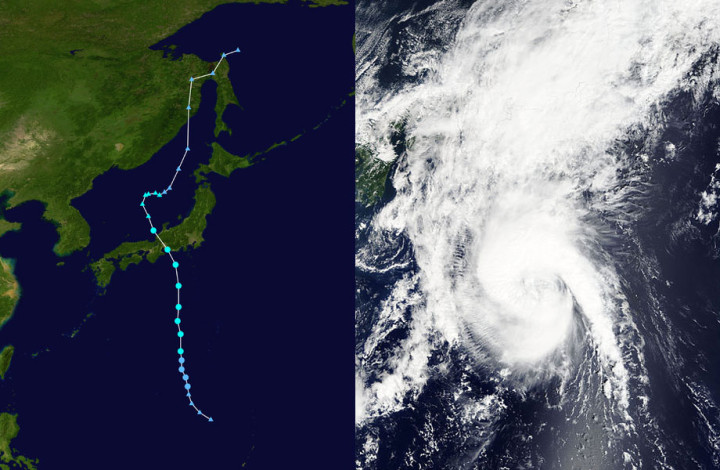Japan just can’t seem to catch a break as extreme forces in nature repeatedly buffet the island.
Efforts are currently underway to coax former Nahara residents, evacuated during the wake of the Fukushima Daiichi triple meltdown, to return to their abandoned homes in the desolated city. Despite assurance that radiation levels in Nahara are now within a ‘safe’ margin, the relatively few who chose immediate return when it officially reopened on September 11, are being issued dosimeters; a reminder that life in this city can never hope to be the same.
Typhoon Etau, with seven confirmed deaths and 15 people still missing, rolled in about the same time as the official reopening of Nahara, driving home the message of perpetual uncertainty in the island nation. The Shibuagawa riverbank succumbed to irresistible watery forces and landslides ravaged the sodden countryside.
By Friday, reopening day for the city of Nahara, flooding from the typhoon reached waist-high in some parts of Japan, forcing large-scale evacuations. Then, drainage pumps at the crippled Fukushima Daiichi reactor, still in crisis, were overwhelmed by floodwaters and failed completely, unleashing a torrent of radioactive water and waste into the already decimated environment.
While Japan was still coming to grips with the impact of Etau on Saturday, Tokyo was hit by an early morning earthquake that registered 5.2 on the Richter scale: a stark reminder of the every day risk from seismic and volcanic disruptions that exists in the Pacific region known as the “Ring of Fire.”
What more could possibly happen to showcase the futility of Japan’s official efforts to rehabilitate its nuclear energy program in defiance of more than 70% of its citizenry’s urging? Then came reports that some of the huge deteriorating plastic bags of radioactive earth and grass that line the Fukushima Daiichi disaster site and adjacent ocean had been swamped and swept away by torrid floodwaters. Ultimately, TEPCO claimed that only 82 of the massive bags were actually lost, with roughly 30 recovered.
Anxious to allay public fears, Japan’s official news reports referred to detected radiation levels around the few recovered bags as “slight.” Those reassurances have fallen on skeptical ears among a public that has grown accustomed to message control that places industrial and political interests above those of public information and public health. The inattentive mainstream media is repeating TEPCO’s unbelievable mantra that the ocean is a ‘big place’ and that many tons of toxic radioactive outflows are only ‘a drop in the bucket’.
In 2013, when Typhoon Man-yi hit northeastern Japan, TEPCO took advantage of the opportunity to drain collected rainwater directly into the Pacific Ocean from the Fukushima Daiichi disaster site, claiming this toxic dump was within ‘safe’ limits of radioactivity.
The TEPCO claim that it is okay to dump ‘safe’ levels of radioactivity into the Pacific Ocean is gravely suspicious with the discovery in February 2015 that for many months highly toxic radioactive rainwater collected on the roof of one of the crippled plant’s buildings was being discharged directly into the Pacific. When finally measured, that allegedly innocuous rainwater registered more than 70-times the radioactive level recorded elsewhere on the site of the Fukushima Daiichi triple meltdowns.
Japan’s citizens and people around the world are wondering if TEPCO was tempted once again to ‘flush’ it’s toxic radioactive toilet full of contaminated water during the cover provided by Typhoon Etau.
Don’t confuse this issue with TEPCO’s acknowledged periodic release of partially treated radioactive groundwater into the Pacific Ocean. Since the initial 2011 catastrophe, groundwater continues to enter the reactor buildings through cracks and breaches becoming highly radioactive and toxic to life. TEPCO alleges that the highly radioactive treated water they continue to release is not significant compared to the size of the ocean.
As the government of Japan continues to declare that the ocean impact from contaminated storm runoff from the Daiichi site is minimal, attention has been completely diverted from the more serious questions concerning the redistribution of toxic radiation and contaminated groundwater through massive rainfall and flooding into previously pristine locations inhabited by innocent people.
Inland impacts are considerable. Typhoon Etau likely washed more radiation from the mountains surrounding the Daiichi disaster than from the nuclear site itself, yet TEPCO and the Japanese government ignore the health impact of these huge, unmonitored releases. Without the government of Japan accepting responsibility for all the contamination caused by the nuclear disaster, the health of the public on both sides of the Pacific Ocean will continue to be jeopardized.
Article by Sue Prent for Fairewinds










